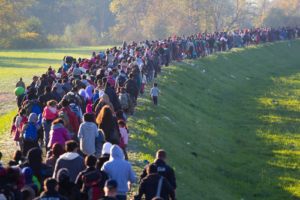The Refugee Conundrum: Why Syrian Asylum Seekers Are Hesitant to Return Home

The conflict in Syria, which displaced millions and led many to seek asylum in Europe, has technically come to an end. Countries like Austria, Greece, the Netherlands, the UK, France, Italy, Belgium, Sweden, Finland, and Norway have suspended new refugee applications, signaling a change in policy toward a crisis that dominated headlines for nearly a decade. However, with approximately four million Syrian refugees still seeking asylum within the European Union, a crucial question arises: What motivates them to stay put rather than return to their homeland?
One poignant account comes from a 27-year-old male refugee, who shared with Welt news, “Why should I go back when I have everything here? In Syria, I no longer have a home, a job, or friends. I’ll only fly to Syria for holidays and to visit family, probably next year when the airport is open again.” Unfortunately, this sentiment is not unique; many refugees are grappling with a blend of nostalgia for their homeland and the harsh realities that keep them tethered to foreign shores.
The New Face of Syria
With the recent shift in power, Syria’s newly elected leader, Abu Mohammad al-Jolani, has ambitious plans to reclaim the war-torn nation. In a statement to an Italian news outlet, he expressed his intentions to restore security and stability across cities while appealing to refugees abroad: “Syria is now a free country that has regained its pride and dignity. Come back. We need to rebuild.” While his enthusiasm is commendable, his statement raises a critical point: the underlying challenges of infrastructure, essential services, and a sense of security must also be addressed.
One might argue that offering a vision of a revitalized Syria could spur some refugees to consider returning. Still, the reality of what awaits them back home—including systematic issues, lack of economic opportunity, and unstable governance—fills many with uncertainty.
European Realities
As we assess the broader implications of this situation, it is important to recognize the impact on European nations, who can sometimes appear overwhelmed by the influx of asylum seekers. For instance, after the influx during Chancellor Angela Merkel’s administration, Germany now has the largest Syrian population in the EU. A staggering statistic reveals that over half of welfare recipients in Germany are foreign-born, with 2.7 million individuals seeking assistance. This shift has earned the AfD Party increased traction among German citizens, who are dissatisfied with continuing to subsidize lives that they believe are no longer legitimate claims on asylum.

The Cost of Refugee Support
In the UK, a similar narrative unfolds. A Syrian refugee shared, “After seven years of living in the UK, I don’t think I will go back. Some of those now in charge of Syria were members of al-Qaeda just a few years ago. I don’t think Syria is safe now, in a few months, and possibly not even in a year.” The financial burden of sustaining each refugee has skyrocketed to £41,000 per annum, further complicating the situation for the governments and taxpayers.
While some have proposed solutions like free air travel back to Syria and cash incentives to encourage return, these ideas rarely hold weight compared to the current comforts and perceived safety of living in developed nations. The allure of stability—not to mention the potential for economic prosperity—often outweighs where one’s heart may lie.
Looking Forward
At Extreme Investor Network, we understand the interconnectedness of economics, migration patterns, and societal change. The refugee crisis reveals two sides of a coin: the struggle for stability and a pressing need for nations to redefine their roles in global humanitarian practices. Moving forward, a collaborative approach—merging on-the-ground support in Syria with realistic and compassionate policies in Europe—will be essential for creating a future where both refugees and host countries can thrive.
The Syrian refugee situation exemplifies a complex blend of human experience, economic strain, and societal dynamics. Not only does it deserve our attention; it calls us to action, urging us to engage deeply with the issues at play. For more on how economic factors shape global trends and the future of investment in humanitarian efforts, dive deeper with us at Extreme Investor Network.

